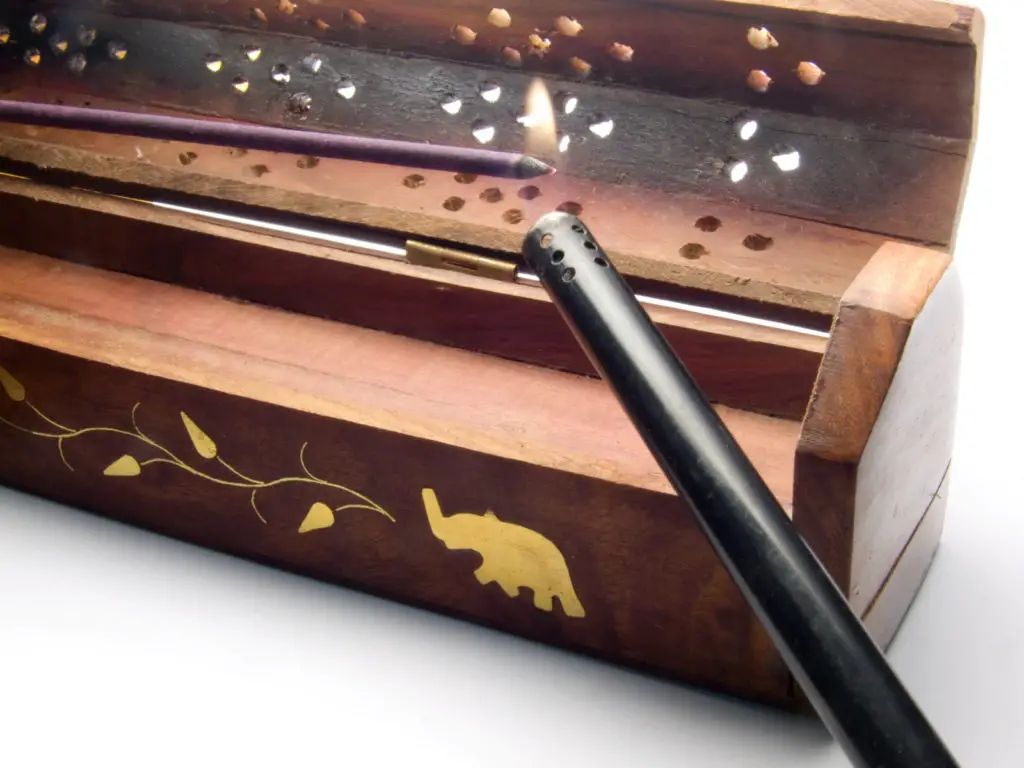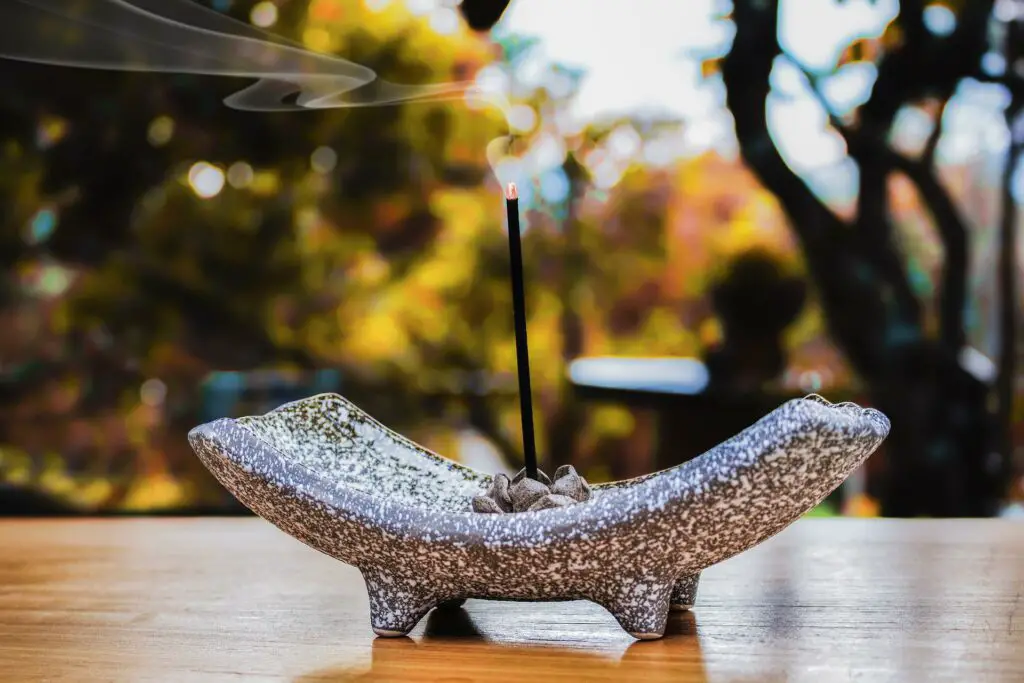So you’ve bought some incense to burn because you love the smell that it produces in home. Sometimes you enjoy relaxing in the aroma it gives off when the soothing smoke wafts around the room.
While at other times, you may use incense to clear the air or perform a ritual.
You burn incense as a way to reduce stress and relax. Or you use it to enhance your meditation or spiritual practice. Using incense is a beautiful way to add fragrance to your home.
But how often should you burn incense? How much is too much?
There’s no real answer to how often you should burn incense. In some temples, incense is burning essentially all the time while people are there. You probably don’t need to go that far, but if incense has a positive effect on you, go ahead and burn as much as you like!
But of course, there are a few things you need to worry about if you’re burning a lot of incense, and ways you can make it better for your health and the environment.
We’ll go over those below.
How Often Should You Burn Incense?

For many centuries, incense has been used for a variety of reasons. This includes religious worship, spell casting, and other ceremonial practices like meditation.
As well as medicinal purposes, such as aromatherapy to reduce anxiety and stress.
Some people only use incense on special occasions, for specific meanings. Others like burning incense every day to support their healing practices, meditation, yoga, etc.
There are no hard or fast rules on how often you should burn incense. It depends on the type of incense that you choose to burn, the space you’re in, and the ventilation.
There are no hard or fast rules on how often you should burn incense. It depends on the type of incense that you choose to burn.
Burning incense is also said to enhance our spiritual connection to divinity and promote emotional healing. For many, incense helps the mind to focus, fosters a sense of inner peace, removes negative energy, and purifies the air (but too much incense can harm the air, more on that later!)
So, you can see why burning incense is a popular practice that many people choose to do each day, or even multiple times per day.
Yet, like with anything, moderation is key. There are potential downsides to burning a lot of incense. Let’s look at those below.
Are You Burning Too Much Incense?

In this section, we’ll look at some of the concerns that could arise from burning too much incense.
1. Excess Smoke Inhalation
If you’re burning a lot of incense, you’re going to be inhaling a lot of smoke. Smoke is bad for your lungs, whether it’s from incense or cigarettes. Be careful!
Always make sure you have adequate ventilation when burning incense. If your space is large enough, you may be able to use a fan or similar device. But if it’s small, open one or more windows.
Always make sure you have adequate ventilation when burning incense.
This is particularly true for stick incenses, because sticks are made by attaching the scented oils and powders to the wooden stick frame. That stick is just wood, and you’ll be inhaling it.
Resins and cone incense are better in this regard. More on this below.
2. Synthetic Fragrances
Many incense brands, even reputable ones, use synthetic products in their formulas. Though they may claim they’re all-natural, there’s not a whole lot of oversight on incense. Even some well-known brands may use synthetic materials in their incense.
So if the smoke produced is breathed in too often, then it can irritate your eyes, nose, and throat. As well as stimulate further respiratory problems.
And depending on the type of incense being used, it can produce so much smoke that it can damage your lungs.
3. Health Issues from Smoke Inhalation
Some people may get health issues from too much incense. It’s not uncommon to experience nausea, dizziness, and headaches when incense is burned.
If you run into this issue, you should either stop burning incense or significantly improve your ventilation and airflow. This is incredibly important.
Incense can also be particularly harmful to cats and dogs, as their smaller bodies will be more likely to inhale a relatively large amount of smoke.
4. Incense is a Potential Fire Hazard
And finally, incense is a fire hazard. If left burning without attention, just like a candle, it can result in a fire. So never leave it unattended. Also, incense can set off smoke alarms quite easily.
The Three Major Types of Incense
Incense comes in three major different forms — sticks, cones, and resins, and ropes. Let’s take a closer look at each one to give you a better idea of how often you should burn them.
1. Incense Sticks
These are the most popular way to burn incense. While it’s easiest to burn stick with a holder, you don’t need anything more than the incense stick. A lighter or match and some creativity will get you delightful-smelling incense.
The sticks are created by binding essential oils and powders onto a bamboo stick. But, you should be aware that not all incense has been created equal.
Many brands will use synthetic fragrances, burning accelerants, and chemical enhancers. These when burned will produce toxic fumes.
Not all incense has been created equal. Many brands will use synthetic fragrances, burning accelerants, and chemical enhancers. These when burned will produce toxic fumes.
It would be best to pay a little bit extra and get an all-natural incense, which will still produce smoke, but at least it won’t be synthetic. In general, a stick of incense will burn for about 40 minutes to an hour if you’re careful.
2. Incense Cones
Cones are the second most popular type of incense used. They are generally made from powders and essential oils, and have no wood frame. They’re a little cleaner-burning than incense sticks, and if you have a backflow burner and backflow cones, you get a beautiful gravity-defying display.
They are similar to using incense sticks, but you light the cone at the top and then allow it to burn. You have to sit the cone on top of an incense burner or strong stone-based plate or slate.
The cone will usually burn for about 30 minutes. How often you decide to use it will depend on the ingredients of the powders and oils used.
Cones generally produce more smoke than incense sticks. Although it’s not guaranteed that all the ingredients are natural.
3. Incense Resins
You have probably hear the Bible story of the three wise men carrying gifts of gold, frankincense, and myrrh to Jesus. Well, the latter two are resins used in incense, which back in the day, were as valuable as gold itself!
Frankincense, also known as Boswellia, has been used for centuries for purification purposes. It was used both in the East and West, as well as by African and South American shamans.
Other popular resins used are copal, benzoin, pinon, and dragon blood. These are made from hardened tree saps. This means they’re guaranteed to be the cleanest way to burn incense… sort of.

Traditionally, these resin incenses were burned with charcoal bricks or discs, typically coated with lighter fluid. They are placed in a censer.
Poison!
But now it is much more common to heat these resins with clean electric resin burner. These just use heat to warm the incense directly, no lighter fluid, no charcoal, no nothing!

This is the best way to use incense, particularly if you like to go through a lot of incense. It’s also probably the cheapest and easiest way to get genuinely high-quality incense.
Conclusion
If you like to burn a lot of incense, burn it as often as you like! We love it too.
But if you really like your incense, it’s a good idea to switch to an electric resin burner and choose resin incense. These are the purest incense, and this method is the safest way to use incense.
And don’t forget to open a window… or two. Your lungs will thank you!






